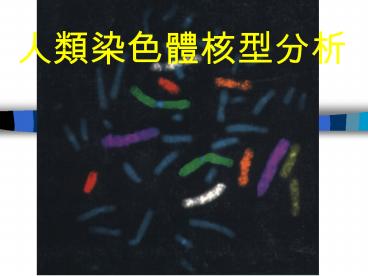????? Chromosome morphology - PowerPoint PPT Presentation
1 / 31
Title: ????? Chromosome morphology
1
?????????
2
????
- ????? Chromosome morphology
- ????? Chromosome abnormal
- ???? Karyotype analysis
3
??????
- Chromatin ???
- Chromatin is the DNA-containing substance
extractable from eukaryotic nuclei - Chromatin is NOT a macromolecule, thus has no
fixed composition
4
??????
- ????
- Isopyconosis without differentiation
- Heteropyconosis with differentiation
- Positively (tightly coiled) v.s. negative
(loosely coiled) - Euchromatin v.s. Heterochromatin
- Euchromatin
- loose structure ? genetically active
- Heterochromatin
- Compact structure ? genetically silent
- Heterochromatin
- Constitutive v.s. facultative
5
Chromomere ???
- Compact form of nucleosome
- Nucleosome
- Basic structure unit of chromosome
6
Nucleosome structure
7
Supercoiled
8
Linear differentiation
- Different degree of coiling
- Telomere
- Centromere
- Chromomere
- Nucleolar organizer
9
Telomere
10
Telomere
11
Centromere
- Kinetochore
- Spindle fiber attachment
- First constriction
12
Chromosome type
- Metacentric
- Submetacentric
- Acrocentric
- Telocentric
13
Nucleolar organizer ??
- Secondary constriction
- The collecting point of nucleolar material ?
nucleolus - Produce 18s and 28s rRNA
14
Tomato telomere
15
Grasshopper telomere
16
Vicia faba chromosome
17
Rye chromomere
18
Zea mays Nucleolar organizer
19
Change in chromosome morphology
- Chromosome break apart
- Reunion
- Ununited
- exchanged
20
Exchange
- Chromosome arm rearrangement
21
Translocation
- Between the arms of different chromosomes
22
Translocation
- Centric fusion
23
Chromosome number variation
- Euploidy
- Aneuploidy
24
Euploidy
type symbol Set of chromosome
monoploid n ABC
Diploid 2n AABBCC
Polyploid
Triploid 3n AAABBBCCC
Tetraploid 4n AAAABBBBCCCC
Pentaploid 5n AAAAABBBBBCCCCC
25
Euploidy
- Allopolyploidy
- Sets of chromosome came from different species
- Autopolyploidy
- Sets of chromosome came from same species
26
Species A 2nAA
Species B 2nBB
Species C 2nCC
F1 2nAB
Autotriploid 3nAAA
Autotetraploid 4nAAAA
Triploid 3nABB
Triploid 3nABC
Allotetraploid 4nAABB
Autohexaploid 6nAAAAAA
Autoallohexaploid 6nAABBBB
Autopetaploid 5nAAAAA
Allohexaploid 6nAABBCC
Autoallooctaploid 8nAAAABBBB
27
Aneuploid
type symbol Number of chromosome
Disomic 2n AABBCC
monosomic 2n-1 AABBC
Nullisomic 2n-2 AABB
Polysomic
Trisomic 2n1 AABBCCC
Double trisomic 2n11 AABBBCCC
Tetrasomic 2n2 AABBCCCC
Pentasomic 2n3 AABBCCCCC
28
Human chromosome
- Chromosome number 46
- Male 44 XY
- Female 44 XX
- 1956 Tjio Levan
- Q-banding fluorescence
- C-Banding Giemsa stain
- G-Banding
- R-Banding
29
Human and rat karyotypes
30
Rules for arranging chromosome
- From Long to short
- If same in length
- Metacentric chromosome
- Submetacentric chromosome
- Acrocentric chromosome
- Telocentric chromosome
31
Karyotype analysis
- Get a photo of chromosomes
- Cut off each chromosome
- Pairing the homologous chromosome
- Draw a base line in a piece of paper
- Arrange the chromosome according to the rules
shown in previous page - Measure each arms of the chromosome pair
- Calculate the fraction of each arm in the total
arms length - Get the short/long arm ratio for each pair of
chromosome - Do a statistics for at least 30 photos































